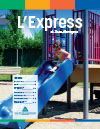Buy Local and Compost!
Autumn is the season where you can really take advantage of all our local products; stores are overflowing with fruits and vegetables from the garden. Enjoy this beautiful time of the year by eating locally produced foods: from your area, province and country.
Some products cannot be purchased locally, but it is always possible to start adding organic or fair trade products to your cart. These products are usually pesticide or chemical-free and they are produced using good practices. If we take the example of meat, we are referring to animals that are free-range, grain fed and hormone free.
A good way to eat locally is to grow your own garden vegetables. Take advantage this autumn to see and taste new vegetables that you can later plant as indoor seedlings in pots, and grow next year in your garden.
Some good reasons to eat local products:
- They’re good for our health because the fresher the food is, the more it contains all the nutrients and vitamins that are essential to good health. In contrast, processed foods contain higher levels of sodium, fat and sugar.
- By eating locally, you encourage farms and producers right here at home! This encourages the local economy and creates jobs in our community.
- Your environment will also win because transporting food over long distances emits a large amount of greenhouse gas (GHG), which increases global warming. By decreasing transportation, you reduce these emissions and help the environment.
Try to identify product origin by checking to see whether it has the “Aliments du Québec” certification logo or the PLU (Price Look-Up) code. This code is a little label with 4 or 5 numbers and it usually identifies the country of origin. If the food in question bears no information on its source, ask a clerk to help you and keep in mind harvest times.
In order to maximize a bountiful harvest, gather family and friends for a community kitchen that will help minimize waste and costs. In addition, it will allow you to plan, exchange and prepare several recipes in a group. It’s a perfect time to get together, get out of the house, and meet and become friends with new people and share knowledge.
Furthermore, you can start composting garden waste, dead foliage from perennials and fallen tree leaves. Composting is a form of recycling and reduces the amount of waste sent to landfills. In fact, approximately 40% of domestic waste can be composted.
Composting promotes the natural decomposition of organic waste from the kitchen or the garden to produce a rich soil that is a natural conditioner for flowerbeds, potted plants or the lawn.
You can compost fruit and vegetables, tea bags, coffee grounds and filters, eggshells, grass clippings, leaves, and garden waste. Please note, we cannot compost bones, meat, fish, milk products, fat and oils and animal excrement.
To prepare a rich compost, you must have: a sufficient quantity of water and air to provide the right conditions for the biological and chemical process, the right temperature, a good container and the proper C:N ratio. That’s the carbon-nitrogen ratio, which has an effect on the decomposition rate in the compost. The ideal C:N is 30:1. Grass clippings, dead plant foliage and kitchen waste are nitrogen-rich materials. Straw, sawdust, and wood chips have high carbon content. Simply mix kitchen waste and dead garden foliage to achieve the ideal ratio.
There are different composter models for you to discover and adapt to your own needs. The model on the right must be covered to protect it from the elements and control the moisture rate, provide holes for circulating the air, and a way to remove the final product. You must place the composter on a flat, sunny, well-drained and easy to access surface that can be reached twelve months of the year! Furthermore, you can compost, even in winter! If you wish, you can buy an affordable composter by calling the Public Works Department of the City of Deux-Montagnes.
The composting process can take from two months to two years, depending on the residues used and the effort provided. The pile should include a good mix of wet and dry waste to accelerate the process. Turn it frequently and make sure residue is shredded or in smaller pieces. The compost is ready to use when it is dark, crumbles and smells “earthy.”
If your compost has an unpleasant odor, ask yourself if there is a solution. If it smells bad, it’s because there is a lack of air or it is too wet. All you need to do is add a rich in nitrogen substance like grass, leaves or manure. If the compost pile does not heat up or seem to be decomposing, it’s due to a lack of moisture or nitrogen. Turning and watering the pile will solve the problem.
Finally, leaves and garden waste that are put out in bags in autumn are collected by the City and sent to an industrial composting site.







